Recycling Centre Corporation: Capacity Analysis, Customer Mapping, Operational Analysis, Strategic Direction
VerifiedAdded on 2023/01/11
|11
|3266
|98
AI Summary
This report discusses the capacity analysis and break even calculations, customer mapping, operational analysis, and strategic direction of Recycling Centre Corporation. It explores the challenges faced by the organization and provides insights on how to improve profitability and meet customer needs. The report also suggests strategic directions using the Ansoff Model.
Contribute Materials
Your contribution can guide someone’s learning journey. Share your
documents today.
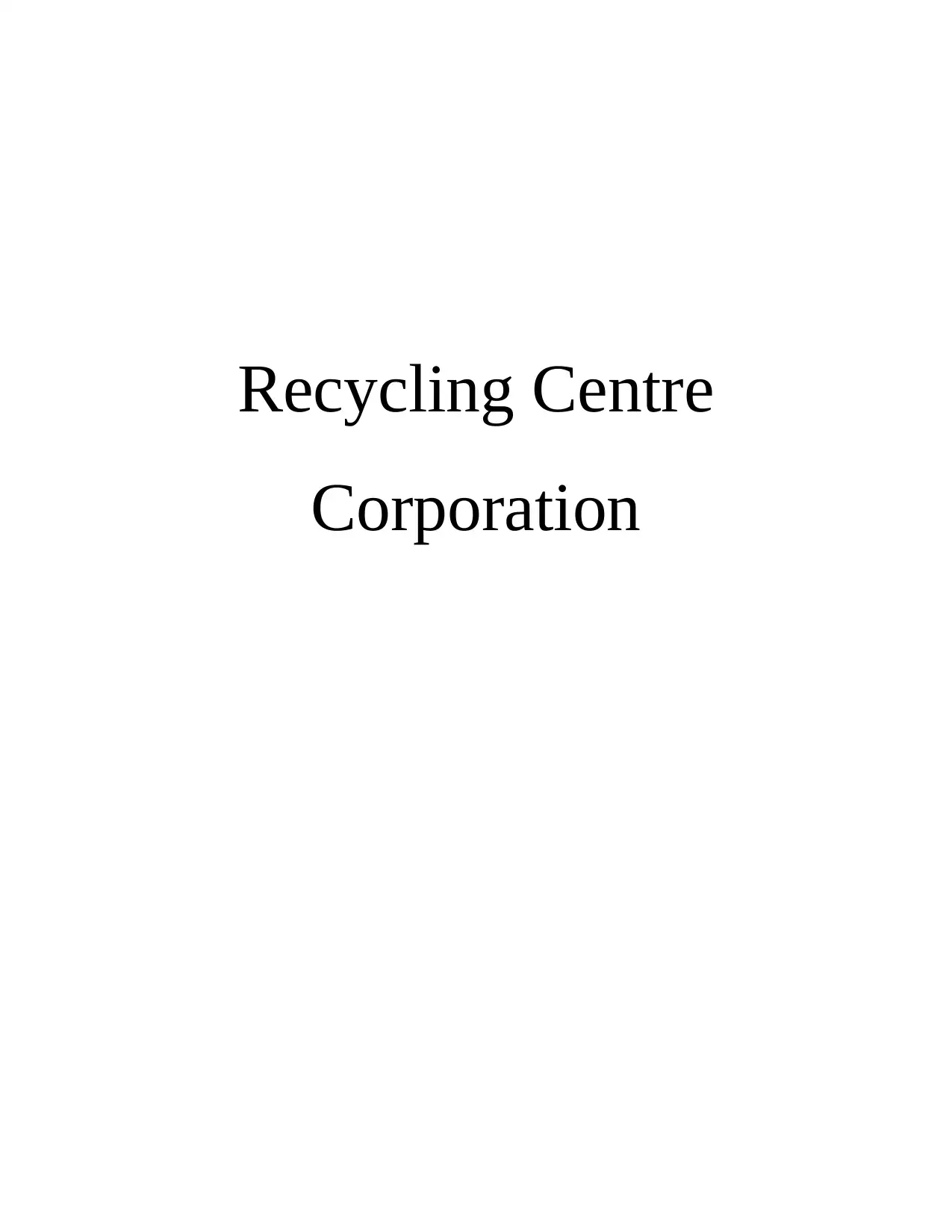
Recycling Centre
Corporation
Corporation
Secure Best Marks with AI Grader
Need help grading? Try our AI Grader for instant feedback on your assignments.
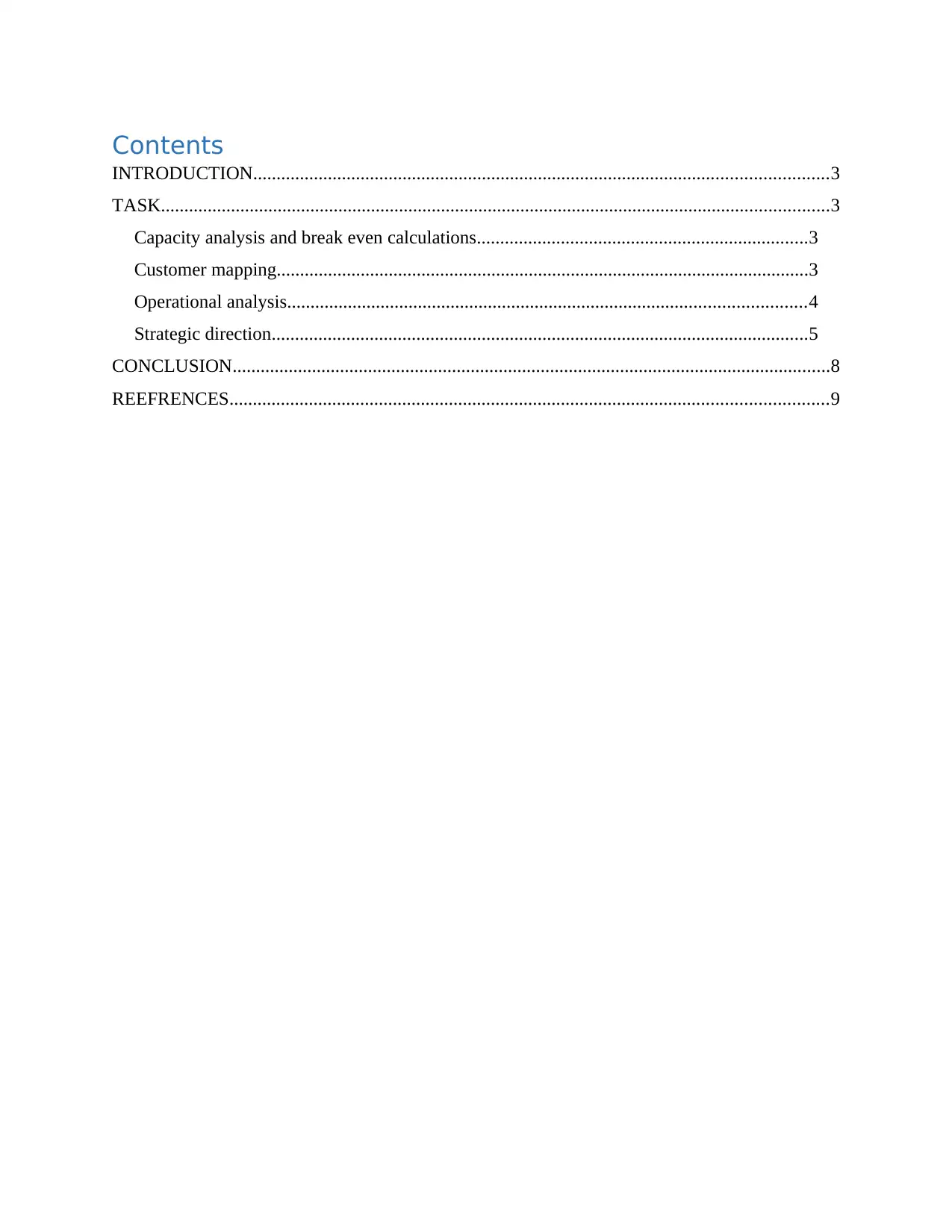
Contents
INTRODUCTION...........................................................................................................................3
TASK...............................................................................................................................................3
Capacity analysis and break even calculations.......................................................................3
Customer mapping..................................................................................................................3
Operational analysis...............................................................................................................4
Strategic direction...................................................................................................................5
CONCLUSION................................................................................................................................8
REEFRENCES................................................................................................................................9
INTRODUCTION...........................................................................................................................3
TASK...............................................................................................................................................3
Capacity analysis and break even calculations.......................................................................3
Customer mapping..................................................................................................................3
Operational analysis...............................................................................................................4
Strategic direction...................................................................................................................5
CONCLUSION................................................................................................................................8
REEFRENCES................................................................................................................................9
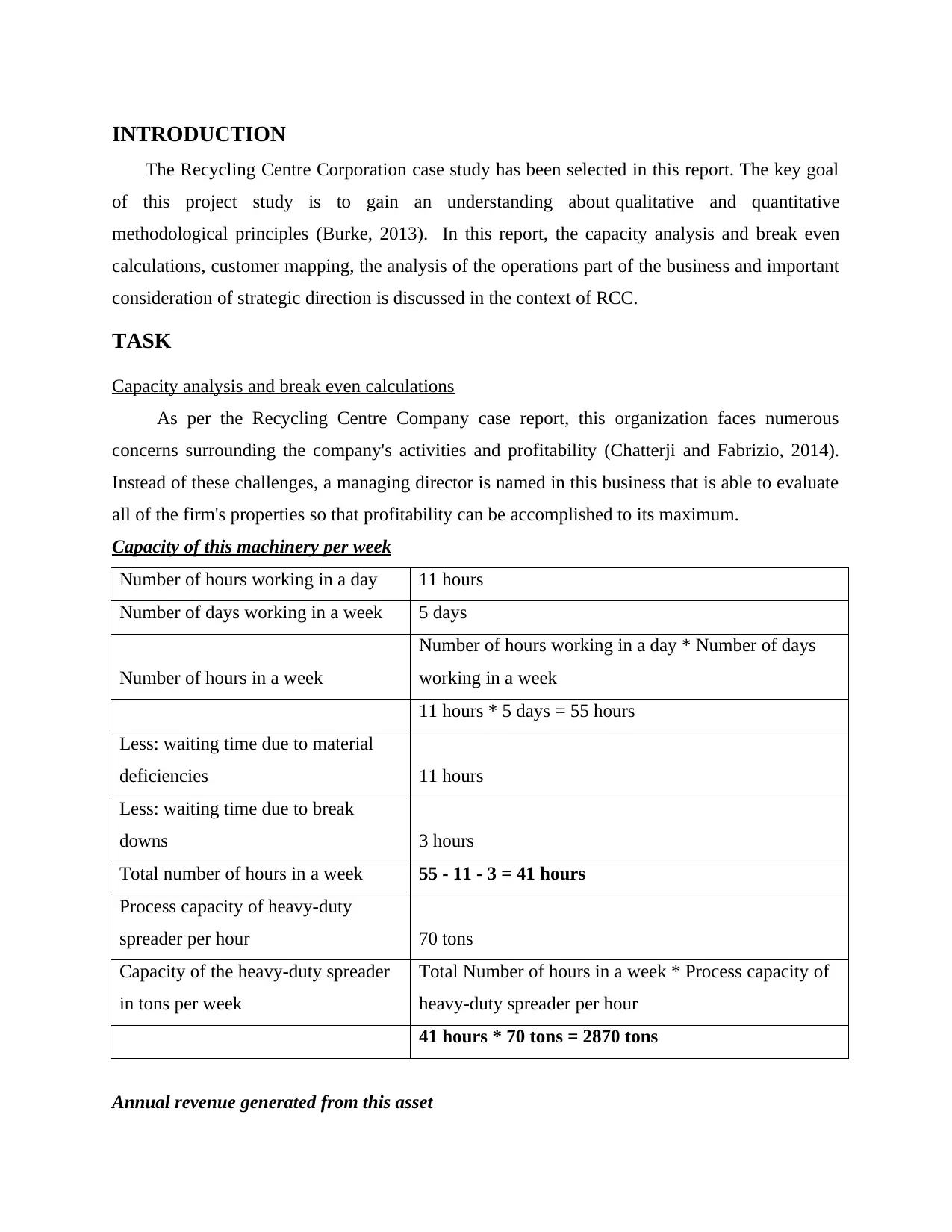
INTRODUCTION
The Recycling Centre Corporation case study has been selected in this report. The key goal
of this project study is to gain an understanding about qualitative and quantitative
methodological principles (Burke, 2013). In this report, the capacity analysis and break even
calculations, customer mapping, the analysis of the operations part of the business and important
consideration of strategic direction is discussed in the context of RCC.
TASK
Capacity analysis and break even calculations
As per the Recycling Centre Company case report, this organization faces numerous
concerns surrounding the company's activities and profitability (Chatterji and Fabrizio, 2014).
Instead of these challenges, a managing director is named in this business that is able to evaluate
all of the firm's properties so that profitability can be accomplished to its maximum.
Capacity of this machinery per week
Number of hours working in a day 11 hours
Number of days working in a week 5 days
Number of hours in a week
Number of hours working in a day * Number of days
working in a week
11 hours * 5 days = 55 hours
Less: waiting time due to material
deficiencies 11 hours
Less: waiting time due to break
downs 3 hours
Total number of hours in a week 55 - 11 - 3 = 41 hours
Process capacity of heavy-duty
spreader per hour 70 tons
Capacity of the heavy-duty spreader
in tons per week
Total Number of hours in a week * Process capacity of
heavy-duty spreader per hour
41 hours * 70 tons = 2870 tons
Annual revenue generated from this asset
The Recycling Centre Corporation case study has been selected in this report. The key goal
of this project study is to gain an understanding about qualitative and quantitative
methodological principles (Burke, 2013). In this report, the capacity analysis and break even
calculations, customer mapping, the analysis of the operations part of the business and important
consideration of strategic direction is discussed in the context of RCC.
TASK
Capacity analysis and break even calculations
As per the Recycling Centre Company case report, this organization faces numerous
concerns surrounding the company's activities and profitability (Chatterji and Fabrizio, 2014).
Instead of these challenges, a managing director is named in this business that is able to evaluate
all of the firm's properties so that profitability can be accomplished to its maximum.
Capacity of this machinery per week
Number of hours working in a day 11 hours
Number of days working in a week 5 days
Number of hours in a week
Number of hours working in a day * Number of days
working in a week
11 hours * 5 days = 55 hours
Less: waiting time due to material
deficiencies 11 hours
Less: waiting time due to break
downs 3 hours
Total number of hours in a week 55 - 11 - 3 = 41 hours
Process capacity of heavy-duty
spreader per hour 70 tons
Capacity of the heavy-duty spreader
in tons per week
Total Number of hours in a week * Process capacity of
heavy-duty spreader per hour
41 hours * 70 tons = 2870 tons
Annual revenue generated from this asset
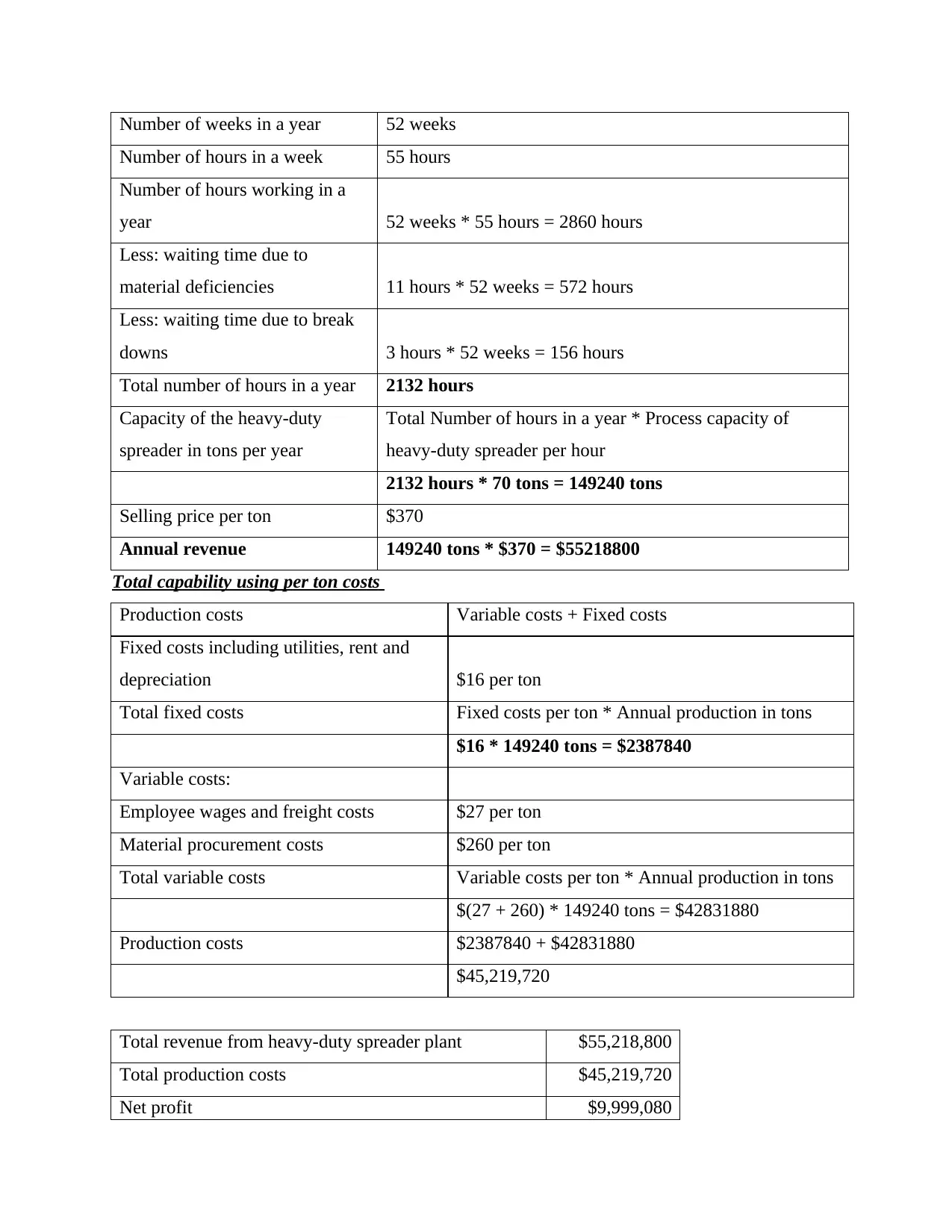
Number of weeks in a year 52 weeks
Number of hours in a week 55 hours
Number of hours working in a
year 52 weeks * 55 hours = 2860 hours
Less: waiting time due to
material deficiencies 11 hours * 52 weeks = 572 hours
Less: waiting time due to break
downs 3 hours * 52 weeks = 156 hours
Total number of hours in a year 2132 hours
Capacity of the heavy-duty
spreader in tons per year
Total Number of hours in a year * Process capacity of
heavy-duty spreader per hour
2132 hours * 70 tons = 149240 tons
Selling price per ton $370
Annual revenue 149240 tons * $370 = $55218800
Total capability using per ton costs
Production costs Variable costs + Fixed costs
Fixed costs including utilities, rent and
depreciation $16 per ton
Total fixed costs Fixed costs per ton * Annual production in tons
$16 * 149240 tons = $2387840
Variable costs:
Employee wages and freight costs $27 per ton
Material procurement costs $260 per ton
Total variable costs Variable costs per ton * Annual production in tons
$(27 + 260) * 149240 tons = $42831880
Production costs $2387840 + $42831880
$45,219,720
Total revenue from heavy-duty spreader plant $55,218,800
Total production costs $45,219,720
Net profit $9,999,080
Number of hours in a week 55 hours
Number of hours working in a
year 52 weeks * 55 hours = 2860 hours
Less: waiting time due to
material deficiencies 11 hours * 52 weeks = 572 hours
Less: waiting time due to break
downs 3 hours * 52 weeks = 156 hours
Total number of hours in a year 2132 hours
Capacity of the heavy-duty
spreader in tons per year
Total Number of hours in a year * Process capacity of
heavy-duty spreader per hour
2132 hours * 70 tons = 149240 tons
Selling price per ton $370
Annual revenue 149240 tons * $370 = $55218800
Total capability using per ton costs
Production costs Variable costs + Fixed costs
Fixed costs including utilities, rent and
depreciation $16 per ton
Total fixed costs Fixed costs per ton * Annual production in tons
$16 * 149240 tons = $2387840
Variable costs:
Employee wages and freight costs $27 per ton
Material procurement costs $260 per ton
Total variable costs Variable costs per ton * Annual production in tons
$(27 + 260) * 149240 tons = $42831880
Production costs $2387840 + $42831880
$45,219,720
Total revenue from heavy-duty spreader plant $55,218,800
Total production costs $45,219,720
Net profit $9,999,080
Secure Best Marks with AI Grader
Need help grading? Try our AI Grader for instant feedback on your assignments.
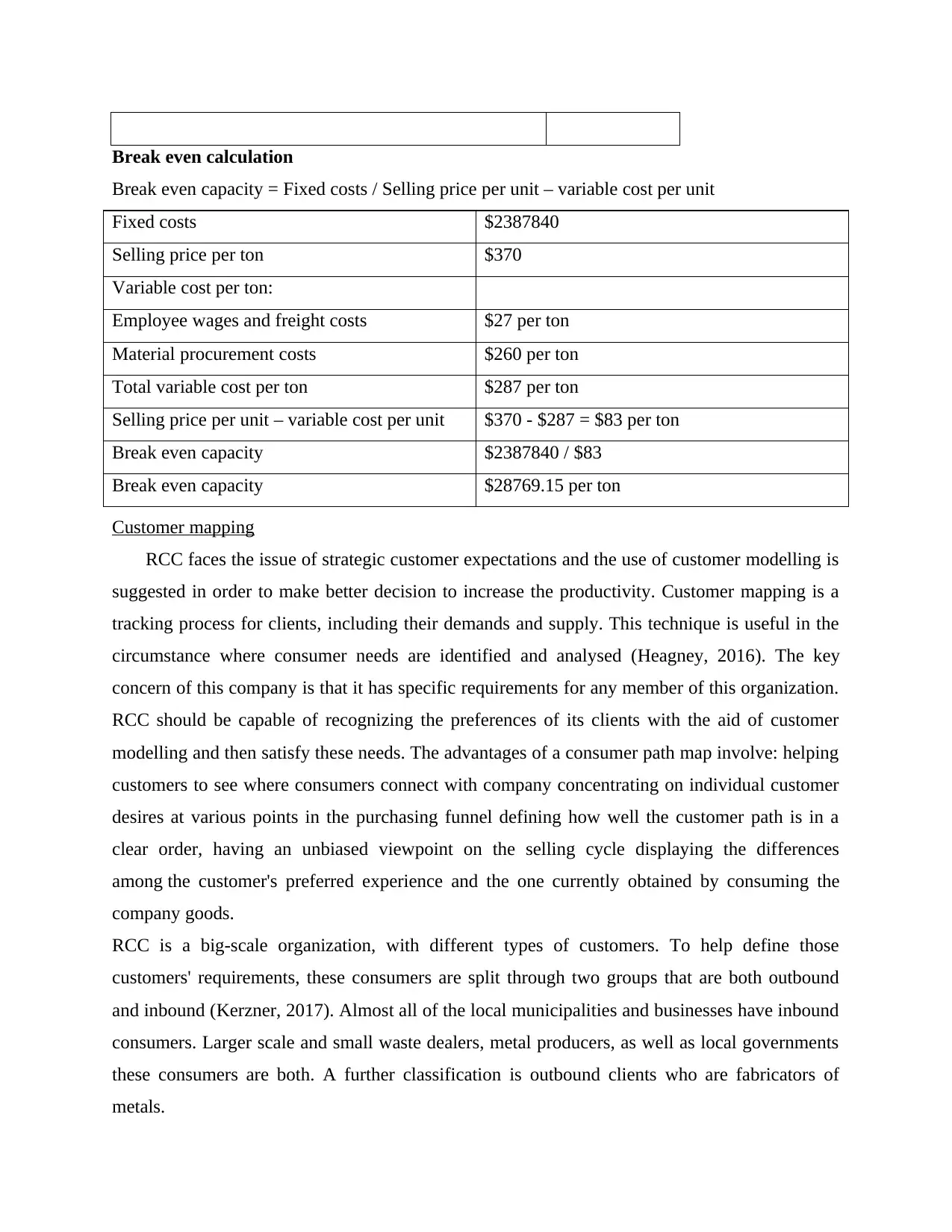
Break even calculation
Break even capacity = Fixed costs / Selling price per unit – variable cost per unit
Fixed costs $2387840
Selling price per ton $370
Variable cost per ton:
Employee wages and freight costs $27 per ton
Material procurement costs $260 per ton
Total variable cost per ton $287 per ton
Selling price per unit – variable cost per unit $370 - $287 = $83 per ton
Break even capacity $2387840 / $83
Break even capacity $28769.15 per ton
Customer mapping
RCC faces the issue of strategic customer expectations and the use of customer modelling is
suggested in order to make better decision to increase the productivity. Customer mapping is a
tracking process for clients, including their demands and supply. This technique is useful in the
circumstance where consumer needs are identified and analysed (Heagney, 2016). The key
concern of this company is that it has specific requirements for any member of this organization.
RCC should be capable of recognizing the preferences of its clients with the aid of customer
modelling and then satisfy these needs. The advantages of a consumer path map involve: helping
customers to see where consumers connect with company concentrating on individual customer
desires at various points in the purchasing funnel defining how well the customer path is in a
clear order, having an unbiased viewpoint on the selling cycle displaying the differences
among the customer's preferred experience and the one currently obtained by consuming the
company goods.
RCC is a big-scale organization, with different types of customers. To help define those
customers' requirements, these consumers are split through two groups that are both outbound
and inbound (Kerzner, 2017). Almost all of the local municipalities and businesses have inbound
consumers. Larger scale and small waste dealers, metal producers, as well as local governments
these consumers are both. A further classification is outbound clients who are fabricators of
metals.
Break even capacity = Fixed costs / Selling price per unit – variable cost per unit
Fixed costs $2387840
Selling price per ton $370
Variable cost per ton:
Employee wages and freight costs $27 per ton
Material procurement costs $260 per ton
Total variable cost per ton $287 per ton
Selling price per unit – variable cost per unit $370 - $287 = $83 per ton
Break even capacity $2387840 / $83
Break even capacity $28769.15 per ton
Customer mapping
RCC faces the issue of strategic customer expectations and the use of customer modelling is
suggested in order to make better decision to increase the productivity. Customer mapping is a
tracking process for clients, including their demands and supply. This technique is useful in the
circumstance where consumer needs are identified and analysed (Heagney, 2016). The key
concern of this company is that it has specific requirements for any member of this organization.
RCC should be capable of recognizing the preferences of its clients with the aid of customer
modelling and then satisfy these needs. The advantages of a consumer path map involve: helping
customers to see where consumers connect with company concentrating on individual customer
desires at various points in the purchasing funnel defining how well the customer path is in a
clear order, having an unbiased viewpoint on the selling cycle displaying the differences
among the customer's preferred experience and the one currently obtained by consuming the
company goods.
RCC is a big-scale organization, with different types of customers. To help define those
customers' requirements, these consumers are split through two groups that are both outbound
and inbound (Kerzner, 2017). Almost all of the local municipalities and businesses have inbound
consumers. Larger scale and small waste dealers, metal producers, as well as local governments
these consumers are both. A further classification is outbound clients who are fabricators of
metals.
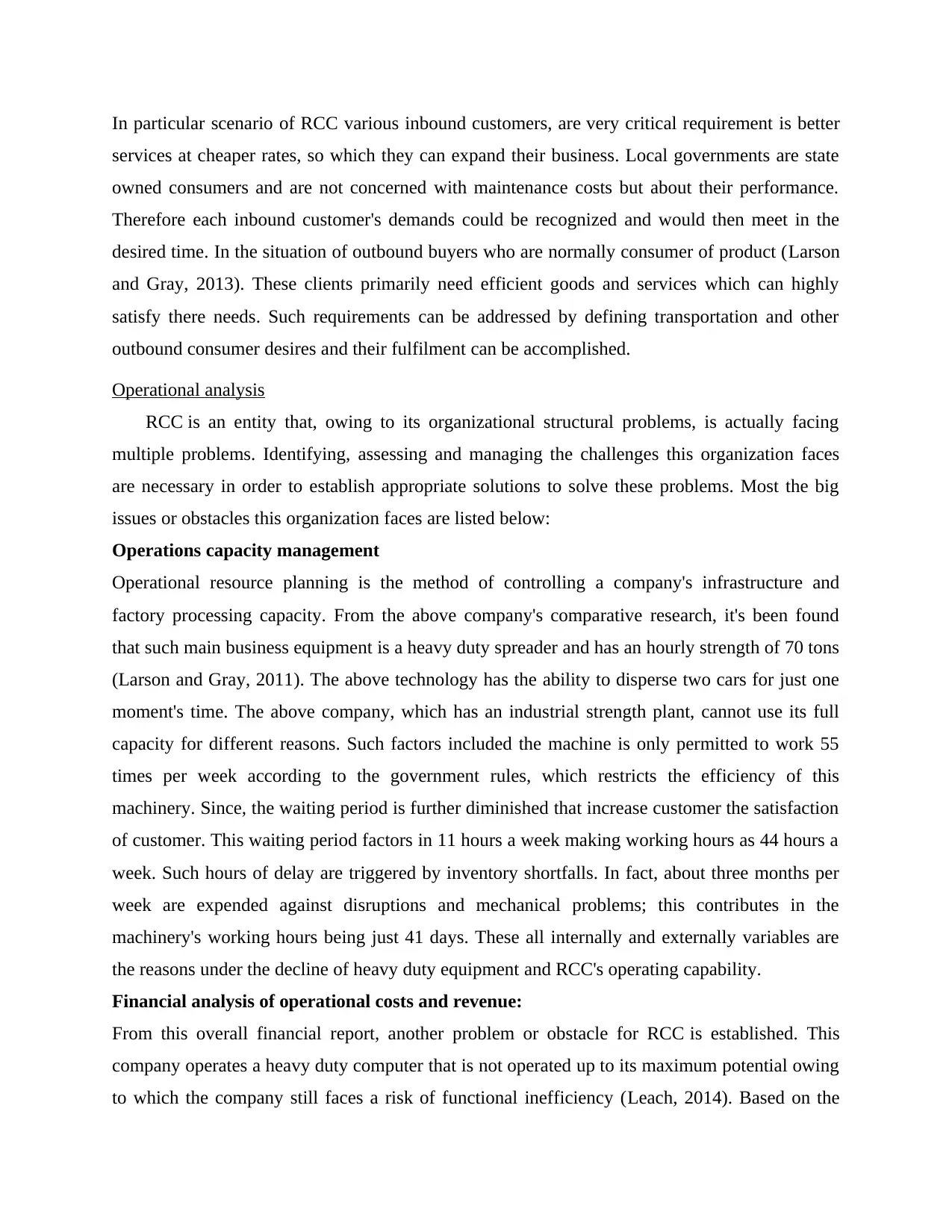
In particular scenario of RCC various inbound customers, are very critical requirement is better
services at cheaper rates, so which they can expand their business. Local governments are state
owned consumers and are not concerned with maintenance costs but about their performance.
Therefore each inbound customer's demands could be recognized and would then meet in the
desired time. In the situation of outbound buyers who are normally consumer of product (Larson
and Gray, 2013). These clients primarily need efficient goods and services which can highly
satisfy there needs. Such requirements can be addressed by defining transportation and other
outbound consumer desires and their fulfilment can be accomplished.
Operational analysis
RCC is an entity that, owing to its organizational structural problems, is actually facing
multiple problems. Identifying, assessing and managing the challenges this organization faces
are necessary in order to establish appropriate solutions to solve these problems. Most the big
issues or obstacles this organization faces are listed below:
Operations capacity management
Operational resource planning is the method of controlling a company's infrastructure and
factory processing capacity. From the above company's comparative research, it's been found
that such main business equipment is a heavy duty spreader and has an hourly strength of 70 tons
(Larson and Gray, 2011). The above technology has the ability to disperse two cars for just one
moment's time. The above company, which has an industrial strength plant, cannot use its full
capacity for different reasons. Such factors included the machine is only permitted to work 55
times per week according to the government rules, which restricts the efficiency of this
machinery. Since, the waiting period is further diminished that increase customer the satisfaction
of customer. This waiting period factors in 11 hours a week making working hours as 44 hours a
week. Such hours of delay are triggered by inventory shortfalls. In fact, about three months per
week are expended against disruptions and mechanical problems; this contributes in the
machinery's working hours being just 41 days. These all internally and externally variables are
the reasons under the decline of heavy duty equipment and RCC's operating capability.
Financial analysis of operational costs and revenue:
From this overall financial report, another problem or obstacle for RCC is established. This
company operates a heavy duty computer that is not operated up to its maximum potential owing
to which the company still faces a risk of functional inefficiency (Leach, 2014). Based on the
services at cheaper rates, so which they can expand their business. Local governments are state
owned consumers and are not concerned with maintenance costs but about their performance.
Therefore each inbound customer's demands could be recognized and would then meet in the
desired time. In the situation of outbound buyers who are normally consumer of product (Larson
and Gray, 2013). These clients primarily need efficient goods and services which can highly
satisfy there needs. Such requirements can be addressed by defining transportation and other
outbound consumer desires and their fulfilment can be accomplished.
Operational analysis
RCC is an entity that, owing to its organizational structural problems, is actually facing
multiple problems. Identifying, assessing and managing the challenges this organization faces
are necessary in order to establish appropriate solutions to solve these problems. Most the big
issues or obstacles this organization faces are listed below:
Operations capacity management
Operational resource planning is the method of controlling a company's infrastructure and
factory processing capacity. From the above company's comparative research, it's been found
that such main business equipment is a heavy duty spreader and has an hourly strength of 70 tons
(Larson and Gray, 2011). The above technology has the ability to disperse two cars for just one
moment's time. The above company, which has an industrial strength plant, cannot use its full
capacity for different reasons. Such factors included the machine is only permitted to work 55
times per week according to the government rules, which restricts the efficiency of this
machinery. Since, the waiting period is further diminished that increase customer the satisfaction
of customer. This waiting period factors in 11 hours a week making working hours as 44 hours a
week. Such hours of delay are triggered by inventory shortfalls. In fact, about three months per
week are expended against disruptions and mechanical problems; this contributes in the
machinery's working hours being just 41 days. These all internally and externally variables are
the reasons under the decline of heavy duty equipment and RCC's operating capability.
Financial analysis of operational costs and revenue:
From this overall financial report, another problem or obstacle for RCC is established. This
company operates a heavy duty computer that is not operated up to its maximum potential owing
to which the company still faces a risk of functional inefficiency (Leach, 2014). Based on the
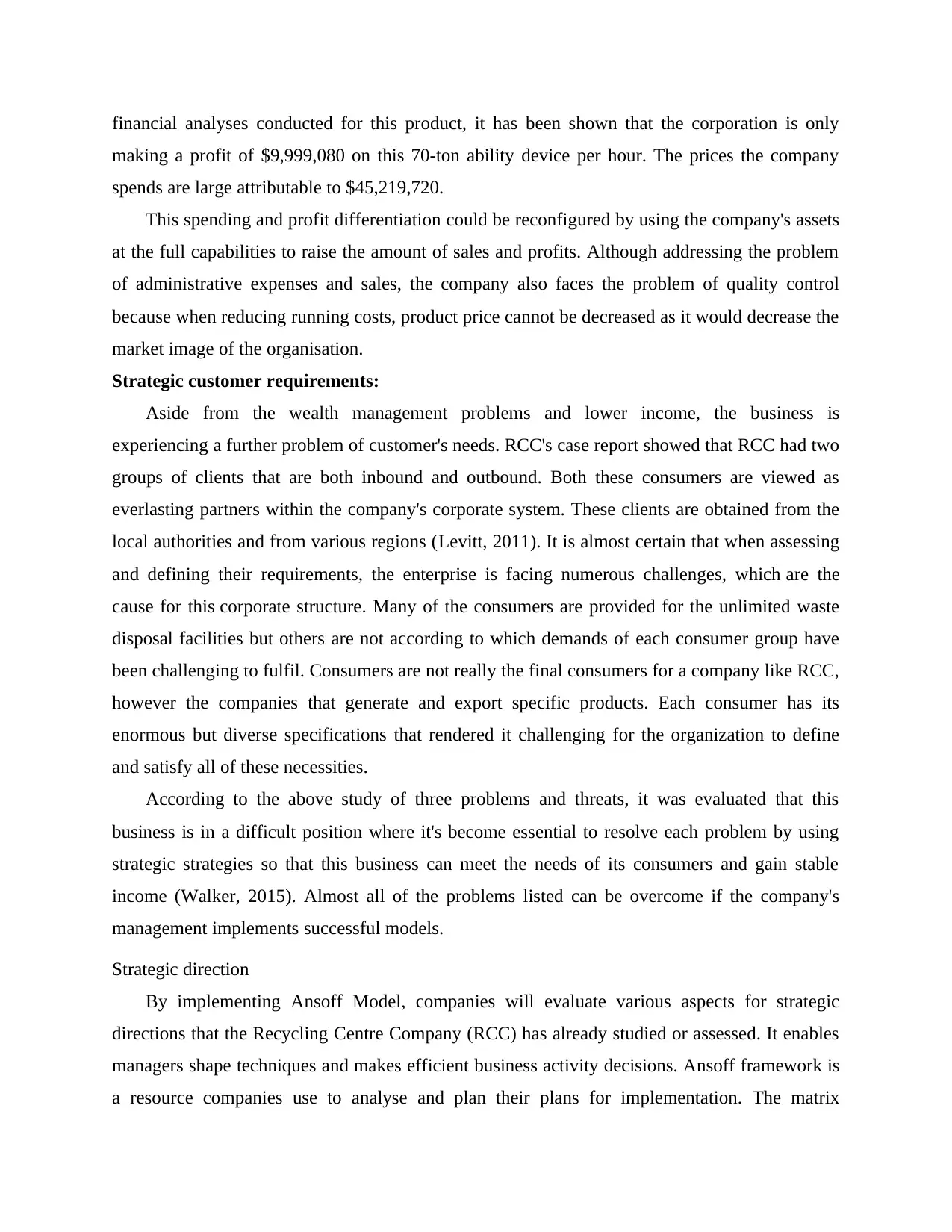
financial analyses conducted for this product, it has been shown that the corporation is only
making a profit of $9,999,080 on this 70-ton ability device per hour. The prices the company
spends are large attributable to $45,219,720.
This spending and profit differentiation could be reconfigured by using the company's assets
at the full capabilities to raise the amount of sales and profits. Although addressing the problem
of administrative expenses and sales, the company also faces the problem of quality control
because when reducing running costs, product price cannot be decreased as it would decrease the
market image of the organisation.
Strategic customer requirements:
Aside from the wealth management problems and lower income, the business is
experiencing a further problem of customer's needs. RCC's case report showed that RCC had two
groups of clients that are both inbound and outbound. Both these consumers are viewed as
everlasting partners within the company's corporate system. These clients are obtained from the
local authorities and from various regions (Levitt, 2011). It is almost certain that when assessing
and defining their requirements, the enterprise is facing numerous challenges, which are the
cause for this corporate structure. Many of the consumers are provided for the unlimited waste
disposal facilities but others are not according to which demands of each consumer group have
been challenging to fulfil. Consumers are not really the final consumers for a company like RCC,
however the companies that generate and export specific products. Each consumer has its
enormous but diverse specifications that rendered it challenging for the organization to define
and satisfy all of these necessities.
According to the above study of three problems and threats, it was evaluated that this
business is in a difficult position where it's become essential to resolve each problem by using
strategic strategies so that this business can meet the needs of its consumers and gain stable
income (Walker, 2015). Almost all of the problems listed can be overcome if the company's
management implements successful models.
Strategic direction
By implementing Ansoff Model, companies will evaluate various aspects for strategic
directions that the Recycling Centre Company (RCC) has already studied or assessed. It enables
managers shape techniques and makes efficient business activity decisions. Ansoff framework is
a resource companies use to analyse and plan their plans for implementation. The matrix
making a profit of $9,999,080 on this 70-ton ability device per hour. The prices the company
spends are large attributable to $45,219,720.
This spending and profit differentiation could be reconfigured by using the company's assets
at the full capabilities to raise the amount of sales and profits. Although addressing the problem
of administrative expenses and sales, the company also faces the problem of quality control
because when reducing running costs, product price cannot be decreased as it would decrease the
market image of the organisation.
Strategic customer requirements:
Aside from the wealth management problems and lower income, the business is
experiencing a further problem of customer's needs. RCC's case report showed that RCC had two
groups of clients that are both inbound and outbound. Both these consumers are viewed as
everlasting partners within the company's corporate system. These clients are obtained from the
local authorities and from various regions (Levitt, 2011). It is almost certain that when assessing
and defining their requirements, the enterprise is facing numerous challenges, which are the
cause for this corporate structure. Many of the consumers are provided for the unlimited waste
disposal facilities but others are not according to which demands of each consumer group have
been challenging to fulfil. Consumers are not really the final consumers for a company like RCC,
however the companies that generate and export specific products. Each consumer has its
enormous but diverse specifications that rendered it challenging for the organization to define
and satisfy all of these necessities.
According to the above study of three problems and threats, it was evaluated that this
business is in a difficult position where it's become essential to resolve each problem by using
strategic strategies so that this business can meet the needs of its consumers and gain stable
income (Walker, 2015). Almost all of the problems listed can be overcome if the company's
management implements successful models.
Strategic direction
By implementing Ansoff Model, companies will evaluate various aspects for strategic
directions that the Recycling Centre Company (RCC) has already studied or assessed. It enables
managers shape techniques and makes efficient business activity decisions. Ansoff framework is
a resource companies use to analyse and plan their plans for implementation. The matrix
Paraphrase This Document
Need a fresh take? Get an instant paraphrase of this document with our AI Paraphraser
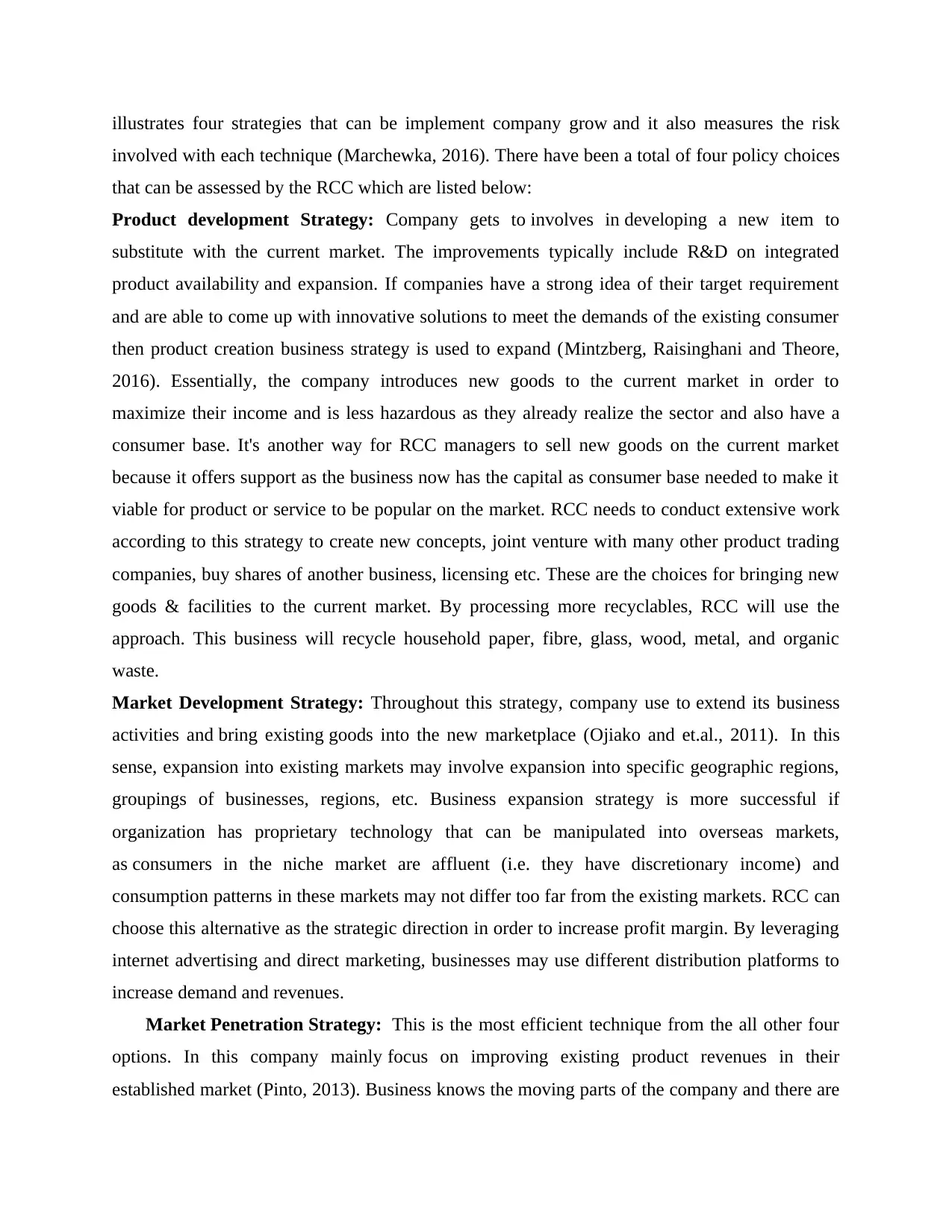
illustrates four strategies that can be implement company grow and it also measures the risk
involved with each technique (Marchewka, 2016). There have been a total of four policy choices
that can be assessed by the RCC which are listed below:
Product development Strategy: Company gets to involves in developing a new item to
substitute with the current market. The improvements typically include R&D on integrated
product availability and expansion. If companies have a strong idea of their target requirement
and are able to come up with innovative solutions to meet the demands of the existing consumer
then product creation business strategy is used to expand (Mintzberg, Raisinghani and Theore,
2016). Essentially, the company introduces new goods to the current market in order to
maximize their income and is less hazardous as they already realize the sector and also have a
consumer base. It's another way for RCC managers to sell new goods on the current market
because it offers support as the business now has the capital as consumer base needed to make it
viable for product or service to be popular on the market. RCC needs to conduct extensive work
according to this strategy to create new concepts, joint venture with many other product trading
companies, buy shares of another business, licensing etc. These are the choices for bringing new
goods & facilities to the current market. By processing more recyclables, RCC will use the
approach. This business will recycle household paper, fibre, glass, wood, metal, and organic
waste.
Market Development Strategy: Throughout this strategy, company use to extend its business
activities and bring existing goods into the new marketplace (Ojiako and et.al., 2011). In this
sense, expansion into existing markets may involve expansion into specific geographic regions,
groupings of businesses, regions, etc. Business expansion strategy is more successful if
organization has proprietary technology that can be manipulated into overseas markets,
as consumers in the niche market are affluent (i.e. they have discretionary income) and
consumption patterns in these markets may not differ too far from the existing markets. RCC can
choose this alternative as the strategic direction in order to increase profit margin. By leveraging
internet advertising and direct marketing, businesses may use different distribution platforms to
increase demand and revenues.
Market Penetration Strategy: This is the most efficient technique from the all other four
options. In this company mainly focus on improving existing product revenues in their
established market (Pinto, 2013). Business knows the moving parts of the company and there are
involved with each technique (Marchewka, 2016). There have been a total of four policy choices
that can be assessed by the RCC which are listed below:
Product development Strategy: Company gets to involves in developing a new item to
substitute with the current market. The improvements typically include R&D on integrated
product availability and expansion. If companies have a strong idea of their target requirement
and are able to come up with innovative solutions to meet the demands of the existing consumer
then product creation business strategy is used to expand (Mintzberg, Raisinghani and Theore,
2016). Essentially, the company introduces new goods to the current market in order to
maximize their income and is less hazardous as they already realize the sector and also have a
consumer base. It's another way for RCC managers to sell new goods on the current market
because it offers support as the business now has the capital as consumer base needed to make it
viable for product or service to be popular on the market. RCC needs to conduct extensive work
according to this strategy to create new concepts, joint venture with many other product trading
companies, buy shares of another business, licensing etc. These are the choices for bringing new
goods & facilities to the current market. By processing more recyclables, RCC will use the
approach. This business will recycle household paper, fibre, glass, wood, metal, and organic
waste.
Market Development Strategy: Throughout this strategy, company use to extend its business
activities and bring existing goods into the new marketplace (Ojiako and et.al., 2011). In this
sense, expansion into existing markets may involve expansion into specific geographic regions,
groupings of businesses, regions, etc. Business expansion strategy is more successful if
organization has proprietary technology that can be manipulated into overseas markets,
as consumers in the niche market are affluent (i.e. they have discretionary income) and
consumption patterns in these markets may not differ too far from the existing markets. RCC can
choose this alternative as the strategic direction in order to increase profit margin. By leveraging
internet advertising and direct marketing, businesses may use different distribution platforms to
increase demand and revenues.
Market Penetration Strategy: This is the most efficient technique from the all other four
options. In this company mainly focus on improving existing product revenues in their
established market (Pinto, 2013). Business knows the moving parts of the company and there are
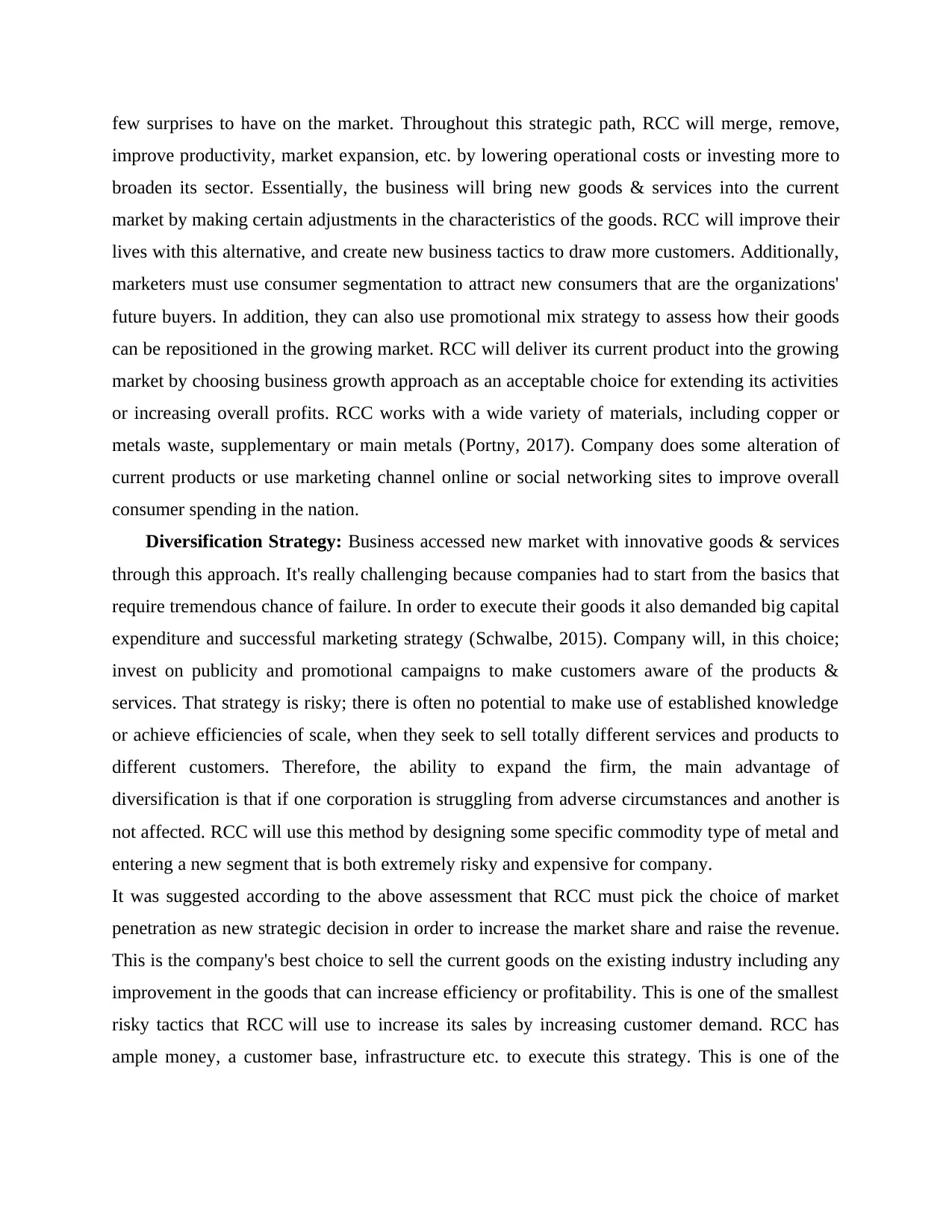
few surprises to have on the market. Throughout this strategic path, RCC will merge, remove,
improve productivity, market expansion, etc. by lowering operational costs or investing more to
broaden its sector. Essentially, the business will bring new goods & services into the current
market by making certain adjustments in the characteristics of the goods. RCC will improve their
lives with this alternative, and create new business tactics to draw more customers. Additionally,
marketers must use consumer segmentation to attract new consumers that are the organizations'
future buyers. In addition, they can also use promotional mix strategy to assess how their goods
can be repositioned in the growing market. RCC will deliver its current product into the growing
market by choosing business growth approach as an acceptable choice for extending its activities
or increasing overall profits. RCC works with a wide variety of materials, including copper or
metals waste, supplementary or main metals (Portny, 2017). Company does some alteration of
current products or use marketing channel online or social networking sites to improve overall
consumer spending in the nation.
Diversification Strategy: Business accessed new market with innovative goods & services
through this approach. It's really challenging because companies had to start from the basics that
require tremendous chance of failure. In order to execute their goods it also demanded big capital
expenditure and successful marketing strategy (Schwalbe, 2015). Company will, in this choice;
invest on publicity and promotional campaigns to make customers aware of the products &
services. That strategy is risky; there is often no potential to make use of established knowledge
or achieve efficiencies of scale, when they seek to sell totally different services and products to
different customers. Therefore, the ability to expand the firm, the main advantage of
diversification is that if one corporation is struggling from adverse circumstances and another is
not affected. RCC will use this method by designing some specific commodity type of metal and
entering a new segment that is both extremely risky and expensive for company.
It was suggested according to the above assessment that RCC must pick the choice of market
penetration as new strategic decision in order to increase the market share and raise the revenue.
This is the company's best choice to sell the current goods on the existing industry including any
improvement in the goods that can increase efficiency or profitability. This is one of the smallest
risky tactics that RCC will use to increase its sales by increasing customer demand. RCC has
ample money, a customer base, infrastructure etc. to execute this strategy. This is one of the
improve productivity, market expansion, etc. by lowering operational costs or investing more to
broaden its sector. Essentially, the business will bring new goods & services into the current
market by making certain adjustments in the characteristics of the goods. RCC will improve their
lives with this alternative, and create new business tactics to draw more customers. Additionally,
marketers must use consumer segmentation to attract new consumers that are the organizations'
future buyers. In addition, they can also use promotional mix strategy to assess how their goods
can be repositioned in the growing market. RCC will deliver its current product into the growing
market by choosing business growth approach as an acceptable choice for extending its activities
or increasing overall profits. RCC works with a wide variety of materials, including copper or
metals waste, supplementary or main metals (Portny, 2017). Company does some alteration of
current products or use marketing channel online or social networking sites to improve overall
consumer spending in the nation.
Diversification Strategy: Business accessed new market with innovative goods & services
through this approach. It's really challenging because companies had to start from the basics that
require tremendous chance of failure. In order to execute their goods it also demanded big capital
expenditure and successful marketing strategy (Schwalbe, 2015). Company will, in this choice;
invest on publicity and promotional campaigns to make customers aware of the products &
services. That strategy is risky; there is often no potential to make use of established knowledge
or achieve efficiencies of scale, when they seek to sell totally different services and products to
different customers. Therefore, the ability to expand the firm, the main advantage of
diversification is that if one corporation is struggling from adverse circumstances and another is
not affected. RCC will use this method by designing some specific commodity type of metal and
entering a new segment that is both extremely risky and expensive for company.
It was suggested according to the above assessment that RCC must pick the choice of market
penetration as new strategic decision in order to increase the market share and raise the revenue.
This is the company's best choice to sell the current goods on the existing industry including any
improvement in the goods that can increase efficiency or profitability. This is one of the smallest
risky tactics that RCC will use to increase its sales by increasing customer demand. RCC has
ample money, a customer base, infrastructure etc. to execute this strategy. This is one of the
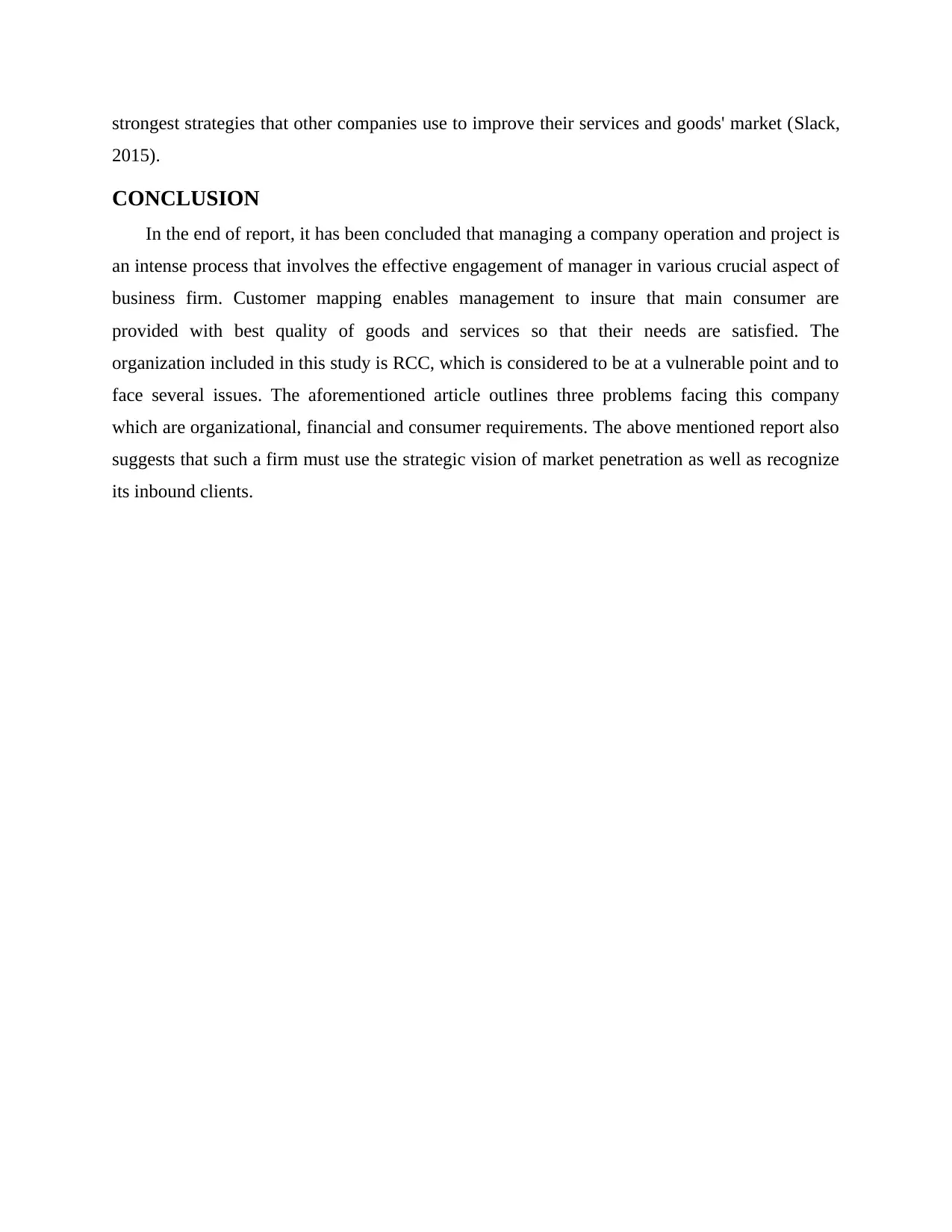
strongest strategies that other companies use to improve their services and goods' market (Slack,
2015).
CONCLUSION
In the end of report, it has been concluded that managing a company operation and project is
an intense process that involves the effective engagement of manager in various crucial aspect of
business firm. Customer mapping enables management to insure that main consumer are
provided with best quality of goods and services so that their needs are satisfied. The
organization included in this study is RCC, which is considered to be at a vulnerable point and to
face several issues. The aforementioned article outlines three problems facing this company
which are organizational, financial and consumer requirements. The above mentioned report also
suggests that such a firm must use the strategic vision of market penetration as well as recognize
its inbound clients.
2015).
CONCLUSION
In the end of report, it has been concluded that managing a company operation and project is
an intense process that involves the effective engagement of manager in various crucial aspect of
business firm. Customer mapping enables management to insure that main consumer are
provided with best quality of goods and services so that their needs are satisfied. The
organization included in this study is RCC, which is considered to be at a vulnerable point and to
face several issues. The aforementioned article outlines three problems facing this company
which are organizational, financial and consumer requirements. The above mentioned report also
suggests that such a firm must use the strategic vision of market penetration as well as recognize
its inbound clients.
Secure Best Marks with AI Grader
Need help grading? Try our AI Grader for instant feedback on your assignments.
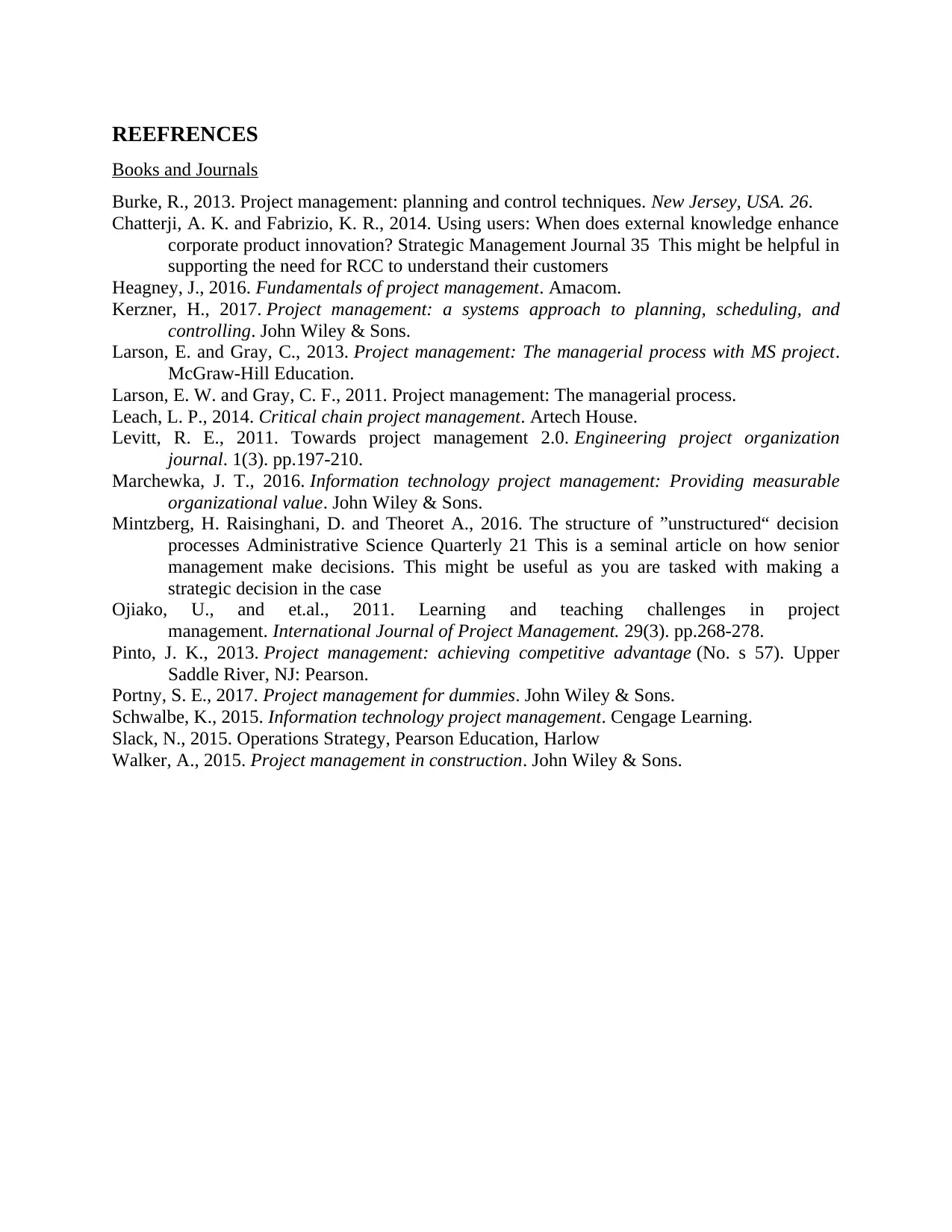
REEFRENCES
Books and Journals
Burke, R., 2013. Project management: planning and control techniques. New Jersey, USA. 26.
Chatterji, A. K. and Fabrizio, K. R., 2014. Using users: When does external knowledge enhance
corporate product innovation? Strategic Management Journal 35 This might be helpful in
supporting the need for RCC to understand their customers
Heagney, J., 2016. Fundamentals of project management. Amacom.
Kerzner, H., 2017. Project management: a systems approach to planning, scheduling, and
controlling. John Wiley & Sons.
Larson, E. and Gray, C., 2013. Project management: The managerial process with MS project.
McGraw-Hill Education.
Larson, E. W. and Gray, C. F., 2011. Project management: The managerial process.
Leach, L. P., 2014. Critical chain project management. Artech House.
Levitt, R. E., 2011. Towards project management 2.0. Engineering project organization
journal. 1(3). pp.197-210.
Marchewka, J. T., 2016. Information technology project management: Providing measurable
organizational value. John Wiley & Sons.
Mintzberg, H. Raisinghani, D. and Theoret A., 2016. The structure of ”unstructured“ decision
processes Administrative Science Quarterly 21 This is a seminal article on how senior
management make decisions. This might be useful as you are tasked with making a
strategic decision in the case
Ojiako, U., and et.al., 2011. Learning and teaching challenges in project
management. International Journal of Project Management. 29(3). pp.268-278.
Pinto, J. K., 2013. Project management: achieving competitive advantage (No. s 57). Upper
Saddle River, NJ: Pearson.
Portny, S. E., 2017. Project management for dummies. John Wiley & Sons.
Schwalbe, K., 2015. Information technology project management. Cengage Learning.
Slack, N., 2015. Operations Strategy, Pearson Education, Harlow
Walker, A., 2015. Project management in construction. John Wiley & Sons.
Books and Journals
Burke, R., 2013. Project management: planning and control techniques. New Jersey, USA. 26.
Chatterji, A. K. and Fabrizio, K. R., 2014. Using users: When does external knowledge enhance
corporate product innovation? Strategic Management Journal 35 This might be helpful in
supporting the need for RCC to understand their customers
Heagney, J., 2016. Fundamentals of project management. Amacom.
Kerzner, H., 2017. Project management: a systems approach to planning, scheduling, and
controlling. John Wiley & Sons.
Larson, E. and Gray, C., 2013. Project management: The managerial process with MS project.
McGraw-Hill Education.
Larson, E. W. and Gray, C. F., 2011. Project management: The managerial process.
Leach, L. P., 2014. Critical chain project management. Artech House.
Levitt, R. E., 2011. Towards project management 2.0. Engineering project organization
journal. 1(3). pp.197-210.
Marchewka, J. T., 2016. Information technology project management: Providing measurable
organizational value. John Wiley & Sons.
Mintzberg, H. Raisinghani, D. and Theoret A., 2016. The structure of ”unstructured“ decision
processes Administrative Science Quarterly 21 This is a seminal article on how senior
management make decisions. This might be useful as you are tasked with making a
strategic decision in the case
Ojiako, U., and et.al., 2011. Learning and teaching challenges in project
management. International Journal of Project Management. 29(3). pp.268-278.
Pinto, J. K., 2013. Project management: achieving competitive advantage (No. s 57). Upper
Saddle River, NJ: Pearson.
Portny, S. E., 2017. Project management for dummies. John Wiley & Sons.
Schwalbe, K., 2015. Information technology project management. Cengage Learning.
Slack, N., 2015. Operations Strategy, Pearson Education, Harlow
Walker, A., 2015. Project management in construction. John Wiley & Sons.
1 out of 11
Related Documents
Your All-in-One AI-Powered Toolkit for Academic Success.
+13062052269
info@desklib.com
Available 24*7 on WhatsApp / Email
![[object Object]](/_next/static/media/star-bottom.7253800d.svg)
Unlock your academic potential
© 2024 | Zucol Services PVT LTD | All rights reserved.





